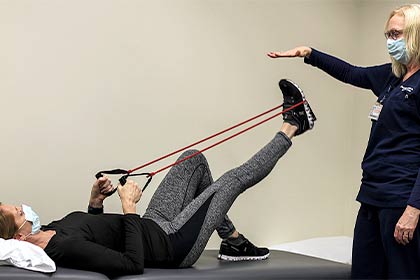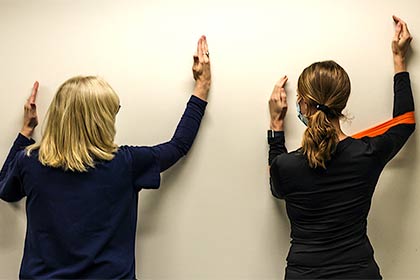

Dr. Bertrand had lived with symptoms for decades before she was diagnosed. Credit: Traci Schwomeyer, Metroplex Headshots
As a child, Kimberly Bertrand, O.D., injured more easily than others and would pass out frequently. As an adult, plantar fasciitis made walking difficult, and spinal stenosis caused recurring neck and back pain.
“I have always felt more fragile than everyone else,” said Dr. Bertrand, an optometrist and Dallas resident. “In my childhood and teenage years and into my mid-30s, most of my issues were with strength and coordination.”
The 46-year-old, who practices in Southlake, grew increasingly desperate for answers. Last May, she sought treatment at UT Southwestern and was diagnosed with hypermobility Ehlers-Danlos syndrome, or EDS.

Isabel Huang, M.D.
Assistant Professor of Physical Medicine & Rehabilitation
“Patients with this genetic disorder struggle with pain, fatigue, and other symptoms that make simple tasks like cooking or getting dressed difficult,” said her doctor, Isabel Huang, M.D., Assistant Professor of Physical Medicine and Rehabilitation.
“Ehlers-Danlos individuals may suffer from a multitude of symptoms that can affect joints, gastrointestinal, cardiovascular, and neurological systems,” Dr. Huang said. “The connective tissue is the issue, which is found everywhere in the body.”
By the time EDS patients come to UT Southwestern, many have already seen numerous doctors and are still searching for an accurate diagnosis and treatment plan. The UTSW Physical Medicine and Rehabilitation specialist team is well equipped to help patients for this rare condition, creating a customized treatment plan for each.
The disease, which affects about one in 5,000 people worldwide, can result in a range of symptoms including headaches; hypermobility (loose, flexible joints); mast cell activation (an allergic-type reaction to certain triggers, such as sunlight or stress); poor circulation; skin that stretches, tears, and bruises easily; digestive complications; lack of bladder control; dizziness; and extreme fatigue. There are 13 types of EDS, categorized by which areas of the body the disease affects. The disorder is often misdiagnosed as fibromyalgia.

Kimberly Bertrand (left) had tried physical therapy in the past, but working with UT Southwestern’s Michelle Munster, Sc.D., an expert in treating EDS patients, made all the difference.
When screening new patients for EDS, Dr. Huang starts with the joints. “We discuss which joints are loose and any other joint-related symptoms they’re experiencing,” she said. “Then we discuss energy levels, chronic pain, and the cardiovascular, gastrointestinal, and muscle systems.”
“We try to see if there is a connection between what seems like random symptoms into one, cohesive diagnosis based on the characteristics of each type of EDS,” Dr. Huang added. “The sooner we can diagnose the disorder, the faster we can help improve a patient’s quality of life with personalized treatment.”
Since EDS has no cure, the goal is to improve quality of life by increasing strength and decreasing pain, discomfort, and fatigue. Physical and occupational therapy can improve joint stability, splints can prevent hyperextension, and strengthening exercises also help. Other treatments include cognitive behavioral therapy, speech therapy to improve swallowing, and medication for pain, insomnia, anxiety, or depression. A daily home exercise routine often improves overall function.

Dr. Munster (left) works with Dr. Bertrand to help her build strength.
For Dr. Bertrand, the diagnosis meant that at last she could put all her nonspecific symptoms into one category.
“Sometimes a diagnosis isn’t helpful because getting it doesn’t cure you or anything,” she said. “But with the knowledge I now have, it gave me direction on where to find help.”
Dr. Huang created a treatment plan that included adding more proteins and electrolytes to Dr. Bertrand’s diet, modifying her activity, and adding a physical/occupational therapy program to strengthen her muscles. Dr. Bertrand noticed her energy levels increased after a couple of months. Today, she can run three miles in under 30 minutes, whereas before she could not walk one mile without pain.
“I feel younger than ever,” she said. “My treatment plan and general awareness of EDS have improved my mental health as well, so I can devote more energy to my physical well-being.”
